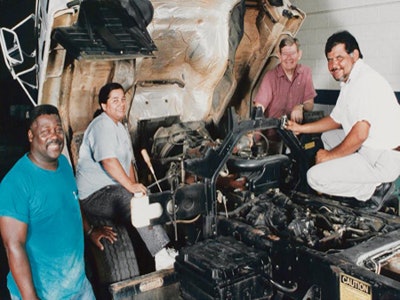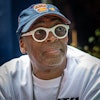Few schools can claim the distinction of having been founded by a saint. The history of St. Philip’s College, however, is intricately woven with the life of Artemisia Bowden, the daughter of a former slave and recently recognized Episcopal saint, who led the institution from 1902 until 1954.
Under Bowden’s watch, the institution evolved from a parochial day school for Black children to a two-year college. She left the college having served as principal, president and dean the same year that the U.S. Supreme Court decided the landmark Brown v. Board of Education case, which ended legalized school segregation. From that point forward, St. Philip’s would be open to students of all racial and ethnic backgrounds.
 St. Philip’s College students and faculty work on some diesel engines.
St. Philip’s College students and faculty work on some diesel engines.Located in San Antonio, Texas, St. Philip’s is the nation’s westernmost HBCU and a member of the five-institution Alamo Colleges District. Now serving more than 13,000 students, the school has made a remarkable transformation influenced by the culture and ever-evolving history of the region.
By 1902, San Antonio was already the largest city in Texas but still only a fraction of the size it is today. Currently the seventh-largest city in the country, San Antonio’s population is highly diverse and the fastest growing in the Lone Star state.
St. Philip’s can also lay claim to another distinction: it is the only institution to have been officially designated as both an HBCU and a Hispanic serving institution (HSI). Currently, more than half of St. Philip’s students are Hispanic, 29 percent are White and 12 percent are Black.
While several HBCUs are now predominantly White, St. Philip’s was the first to become majority Hispanic. Other HBCUs are following in St. Philip’s footsteps to become more diverse, particularly in areas with large Hispanic populations.
Paul Quinn College (PQC), a small four-year HBCU in Dallas, Texas, for instance, named its first Latina Miss PQC in 2013. Tanya Torres, a Fisk University student, will become the first Hispanic to serve as president of the student government association at the 151-year-old HBCU.
This trend is part of a broader shift in demographics in the United States that experts say can be expected to continue.
“I think we can be comfortable in assuming that Latino representation overall, but certainly Latino representation at HBCUs, is going to grow,” says Dr. Deborah A. Santiago, chief operating officer and vice president for policy at Excelencia in Education, a Washington, D.C.-based nonprofit that seeks to advance and support Latino achievement in higher education.
In contrast to HBCUs, which are defined by their historic mission of providing access to higher education for Black students at a time when Blacks were barred from attending majority-White institutions, HSIs gain their designation by student enrollment numbers. To be named an HSI, a school’s student population must be 25 percent or more Hispanic.
The number of high school graduates is expected to decline nationally in the years to come, while the proportion of Hispanic high school graduates is projected to increase.
Dual identity
St. Philip’s is a good example of an institution that has embraced both its HBCU and HSI identity, and the college does not see this dual identity as “an either-or paradigm,” Santiago says.
Many of the gains in Hispanic student enrollments at HBCUs have taken place at schools in the Southwest like St. Philip’s, while other, more northerly schools, such as Howard University, Delaware State University and Lincoln University of Pennsylvania, are also beginning to welcome more Latino students.
Located just three miles away from the Fort Sam Houston Army Base, St. Philip’s has a sizable military student population. Angelia Jacobs, a veteran and president of the St. Philip’s Student Government Association for the upcoming academic year, says that, when she retired from the military, other veterans recommended that she apply to St. Philip’s. “Even though there were a lot of other places in the vicinity, this was the place of choice for me,” Jacobs explains.
Jacobs completed her associate’s degree in dental hygiene in 2014 and works as a church administrator and Mary Kay sales representative. She has returned to St. Philip’s to take courses that will allow her to transfer to a four-year school, and she is an alternate student trustee for the Alamo Colleges District.
“You get a good education,” Jacobs continues. “Some of the students were able to take classes here at St. Philip’s either nights or weekends, things like that, even while they were on active duty. So it just made sense for a good fit.”
As St. Philip’s looks to the future, however, it faces certain challenges.
The Southern Association of Colleges and Schools Commission on Colleges (SACSCOC) placed St. Philip’s on warning in December 2016, along with two other institutions within the Alamo Colleges District. The warning came about due to concerns that the system was representing itself as one institution as opposed to five distinct colleges, raising questions about the autonomy of the five schools within the district.
The institution retains its accreditation and will undergo another review process this December. A school representative noted that this is the first time that the school has been placed on warning in the entirety of its history and that the institution is working to address the commission’s concerns.
A rich history
When its doors opened in 1898, St. Philip’s functioned as a Sunday night sewing class for African-American girls. Soon, with assistance from the Episcopal Church, the school expanded to become a day school for African-American children in the area, many of whom were just one generation away from slavery.
At the time, there were few employment opportunities for San Antonio’s small African-American population, other than manual or domestic labor.
St. Philip’s was intended to educate the “hand, heart and mind” of Black students in San Antonio, expanding their professional opportunities beyond what had been available to their parents.
Bowden arrived at St. Philip’s in 1902 when it was still known as St. Philip’s Industrial School. The Georgia-born Bowden was a graduate of St. Augustine’s College in Raleigh, North Carolina, and had taught at a number of schools when she received an invitation to be the head of St. Philip’s.
Summoned to travel out west by train wearing a red ribbon on her shoulder so that the person meeting her at the San Antonio station could identify her, Bowden could not have anticipated the challenges and successes that lay ahead. In the earliest years, her challenge was to keep the severely under-resourced school’s doors open. She did this while simultaneously ensuring that first through ninth graders were taught all of the relevant academic subjects, along with practical skills that might allow them to pursue a trade and better their place in society.
No doubt Bowden would be amazed to see the many changes that have taken place at the school decades after her death in 1969.
Throughout much of its history, St. Philip’s served the local community, but today casts a much wider net. Students come to St. Philip’s from the surrounding counties, with fewer than 10 percent from the immediate zip code.
“When I first got here, I think it was more like 3 or 4 percent in the immediate zip code, and I’m talking about both campuses,” says Dr. Paul Machen II, dean of student success at St. Philip’s. “I think it was just the nature of our programs.”
The school will always attract students from far afield because it
is one of the few places that offers certain vocational programs, and sometimes it is the only one. For instance, St. Philip’s offers the only construction — welding, advanced manufacturing, aviation engine, alternative energy, diesel, collision refinishing and automotive training — in the South Texas region, school officials say. Still, college officials say that they want to be sure they are making connections with the local community.
“We have some unique kinds of programs where we’re the only game in town,” Machen says. “That keeps up a steady pipeline.
With that being said, the reason we were started was because of a social need, our community need.”
The school is an economic engine in the region, building on its origins as an industrial school to meet the needs of local economies, from San Antonio’s burgeoning food scene through its culinary arts program, to partnering with local businesses on a wide range of initiatives. San Antonio’s Eastside, the community where St. Philip’s is located, was the center of San Antonio’s Black community for decades. Today, it is majority Hispanic.
Bowden might also be surprised to see how far away the institution has moved from its former identity as a majority-Black institution. Yet, St. Philip’s still celebrates that historic connection and accentuates its identity as an HBCU. St. Philip’s students have been named HBCU All-Stars, a White House Initiative on HBCUs endeavor that annually recognizes outstanding undergraduate, graduate and professional students currently attending an HBCU.
“Even prior to the HBCU All-Stars, we would always have someone in our Fine Arts (program) and choir participate in 105 Voices,” says Dr. Erick Akins, incoming president of the National Association of HBCU Title III Administrators and Title III administrator at St. Philip’s. Performers in the 105 Voices of History national choir represented each of the nation’s 105 HBCUs.
Although the school only gained official HBCU designation 30 years ago, Bowden was a seminal HBCU leader in a league along with early HBCU presidents like Mary McLeod Bethune.
Bowden and Bethune, who both led schools for African-American children that later became colleges, were friends and correspondents. The two women were also both resourceful fundraisers, raising money to keep their schools afloat through baked goods sales and their connections with local churches.
“That history is extremely important because it’s a legacy tied to that kinship that exists between all HBCUs,” Akins says. “I think within the HBCU community it’s all about family, the struggles of the people who went before you, and doing the things we need to do now.”
Catherine Morris can be reached at [email protected].
- This story also appears in the August 10, 2017 print edition of Diverse.


















